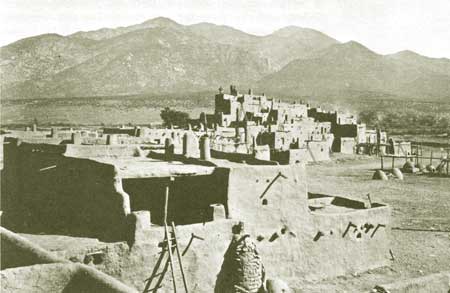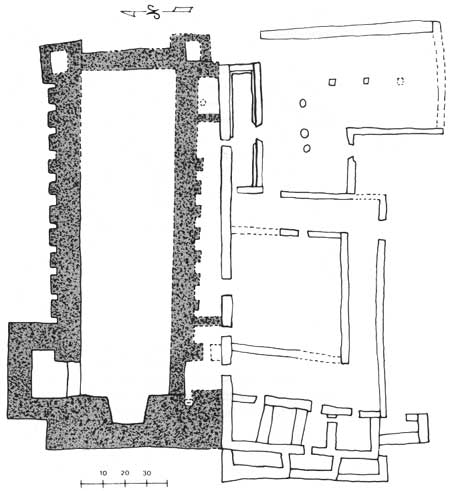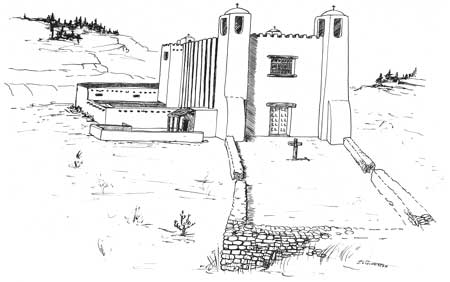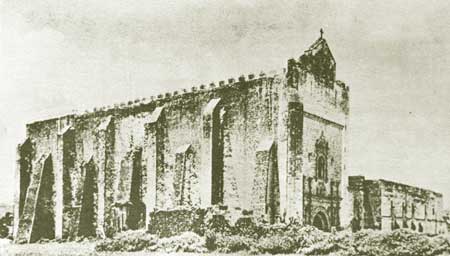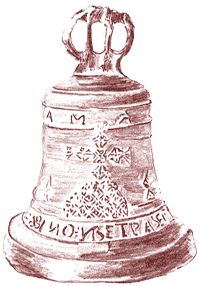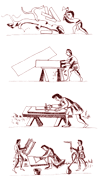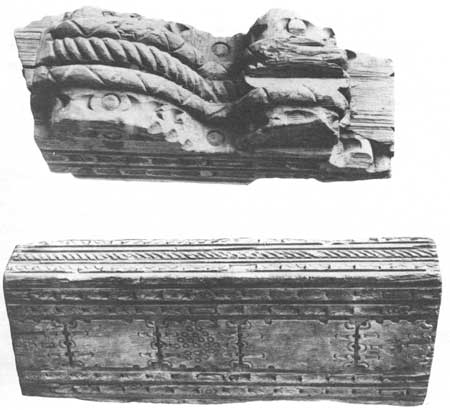

Contents Foreword Preface The Invaders 1540-1542 The New Mexico: Preliminaries to Conquest 1542-1595 Oñate's Disenchantment 1595-1617 The "Christianization" of Pecos 1617-1659 The Shadow of the Inquisition 1659-1680 Their Own Worst Enemies 1680-1704 Pecos and the Friars 1704-1794 Pecos, the Plains, and the Provincias Internas 1704-1794 Toward Extinction 1794-1840 Epilogue Abbreviations Notes Bibliography |
Respite in Church-State Conflict The peacemaker arrived in October 1621. Sent out from the Convento Grande, Fray Miguel de Chavarría, newly appointed custos of New Mexico, made no pretense. He warmly embraced Governor Eulate. Ex-custos Perea blanched. Here once again was Christ in the embrace of Judas Iscariot. The two friars' exchange at chapter must have been tense. There was no common ground save their faith. Veteran Perea, mulish protector of the church, knew what the perfidious Eulate was capable of. Chavarría, the administrator from headquarters, had come to restore harmony. The viceroy had decreed it. Surely, as God's children, they could work things out. Perea did not think so. His one hope to save the church in New Mexico from the anti-christ Eulate was to present the facts in person in Mexico City. But Chavarría would not let him go. There was a reason for Custos Chavarría's conciliatory attitude toward Eulate, beyond Perea's allegation that they were old buddies. The viceroy's instructions had plainly laid the onus on the Franciscans. With the contending parties' "letters, missives, memorials, depositions, and other documents" before them, the viceroy and his advisers had been more offended by the picture of a royal governor, excommunicate, shackled, doing humiliating public penance before omnipotent friars than by alleged crimes against the church and morality. The friars must cease their interference in secular affairs. Getting down to specifics, the viceroy admonished both custos and governor not to meddle in the annual elections of native pueblo officials; he cautioned the friars not to obstruct the collection of tribute from pueblos like Pecos that had already been granted in encomienda, at the same time ordering that no tributes be exacted from unconverted pueblos like those of Zuñi and Hopi. He instructed the governor to provide escorts for the friars and forbade him to let Spaniards run livestock within three leagues of the pueblos; he told the missionaries to stop cutting the Indians' hair as punishment; and he tried, from fifteen hundred miles away, to decree an end to illegal use of Indian labor by colonist and missionary alike. Even though abuses persisted, the heads of church and state now greeted each other in public, while ex-custos Perea fumed. [30]
Juárez to Pecos; Ortega to Taos At Pecos, the missionary effort picked up. Just why Custos Chavarría recalled Fray Pedro de Ortega and moved Andrés Juárez over from Santo Domingo is not clear. Certainly Ortega's abortive attempts to discipline the idolater Mosoyo and to build a church had put him in a compromising position. His smashing of Pecos idols had sorely strained his relations with the people. From all indications, Father Juárez—like the renowned sixteenth-century Franciscan Bernardino de Sahagún—was more tolerant, more willing to accept the Pecos as they were, to learn their language and their ways, and to use this acquaintance to guide them toward a Christian salvation. To change their hearts, he relied not on destruction of pagan symbols, but rather on the infinite grace of God, the God of the New Testament. As for Fray Pedro de Ortega, he took up a heavier cross. Assigned to the conversion of Taos, he all but won the martyr's crown. In the beginning, "the idolatrous Indians illtreated him to prevent him from remaining there and preaching our holy Catholic faith. For food they gave him tortillas of maize made with urine and mice meat, but he used to say that for a good appetite, there is no bad bread, and that the tortillas tasted fine." When they refused him lodging, he laid up a shelter of branches and persevered in the cold. First he converted "the principal captain." Others followed and helped him build a decent convento. Then one night as he sat by the fire, an Indian, an ally of "the priests of the idols," leveled an arrow at him. Just as the would-be assassin was about to let fly, a Spaniard's dog startled him. He ran. The dog gave chase. Before he could scale the garden wall, the animal was on him tearing his flesh. They found him dying. There was time only for the friar to absolve and baptize him. "When all those who were not yet baptized and converted saw this punishment from God, they conceived a great love and veneration for the blessed father and [they themselves] were converted and baptized." [31] Church Building Resumed While Pedro de Ortega was reportedly winning over the disinclined Taos, Fray Andrés Juárez resumed construction at Pecos. How much he could utilize of what Ortega had done before the stoppage in 1621, Juárez did not say. But by the time Custos Chavarría visited the pueblo, presumably in mid-1622, the structure was taking shape. Fray Andrés, writing to the viceroy on October 2, explained
Juárez was an accomplished beggar. He also wanted some new priestly vestments because the old ones were "already all torn to pieces." Either he was bidding for an ayuda de costa from the royal treasury, the traditional one-thousand-peso initial grant to new churches for bells, altar furnishings, vestments, etc.—which may already have been spent on Pecos—or for a special pious donation. Whatever the case, the astute Franciscan vowed that the altar piece would be installed at Pecos in the viceroy's name so that "the Blessed Virgin might reward the concern of Your Excellency and so that these poor recent converts might be brought to a knowledge of the greatest truth in Our Holy Catholic Faith." He kept pressing. Pecos was not just any pueblo, "as Your Excellency can verify." To Pecos every year came numerous "heathens, called the Apache nation," people from the plains.
That year, 1622, building preoccupied Andrés Juárez. The supply wagons were finally about to return to Mexico City after many months' delay. Like some of his fellow missionaries, Fray Andrés took this opportunity to write the highest-ranking official in New Spain. Of nine letters sent, only his was non-partisan. He alone confined himself to the immediate needs of his mission, while the others took sides, most of them, like Zambrano Ortiz, vehemently denouncing Governor Eulate and, by implication, their superior who had tried to appease him. Custos Chavarría was also leaving. After only a year in the missions, he felt compelled to return to Mexico City to defend himself against the barbs of his fellow Franciscans. In letters to the viceroy, the Convento Grande, and the Inquisition, Perea and his party had flayed Governor Eulate, citing again and again his obscene disregard for the viceroy's instructions. At the same time, they had portrayed Custos Chavarría as the governor's toady. Few friars dared stand by Chavarría. One who did was old Alonso Peinado. He praised the custos' efforts to calm the troubled waters and to propagate the faith, especially among the Pecos, Jémez, Taos, and Southern Tiwas. With another six friars he would have reduced the Piros and Tompiros, "who are on the verge." He had encouraged church construction. At Santa Fe, the foundations had been laid for a convento and a church that Father Peinado believed "will be the best in this land," Evidently he had not seen Pecos. [34] A Church to Match the Pueblo The Pecos project was monumental. The pueblo's size, consequence, and self-respect dictated that its church be the best in the land. Plans called for a nave as wide inside as the largest available pine beams would span, forty-one feet at the entrance, tapering to thirty-seven and a half feet at the sanctuary. Height of ceiling would approximate width. The number of Pecos Indians, that is the size of the potential congregation, determined length—a remarkable one hundred and forty-five feet from entrance to the farthest recess of the apse. Wall thickness varied from eight to ten feet down the sides between buttresses, to twenty-two feet at the back corners where two of the planned towers would rise. [35] Outside, the massive structure, with its rows of rectangular ground-to roof buttresses up the lateral walls, its six towers, and its crenelated parapet would look as much like a fortress as a church—a reflection not of Father Juárez' fear of attack, but rather of his European heritage. 300,000 Adobes Such an undertaking laid a heavy burden on the Pecos. Each sun-dried mud block, about 9-1/2 by 18 by 3 inches, weighed forty pounds or so. Gray to black in color and containing bits of bone, charcoal, and pottery, the earth must have been dug from the trash mounds that had accumulated along the edges of the mesilla. The job would require 300,000 adobes. While the men hauled earth and water and the great quantity of wood needed for scaffolding, the actual laying up of walls in Pueblo society was women's work. "If we force some man to build a wall," wrote Fray Alonso de Benavides, "he runs away from it, and the women laugh." [36] The friars were always quick to condemn Juan de Eulate as an "enemy of churches" when he opposed their construction. Yet his complaints to the viceroy that the missionaries demanded endless free labor from the Indians to build and maintain excessively grandiose structures, that such work kept the natives from cultivating their fields, and that it monopolized the oxen and skills of neighboring colonists, may have been founded as much on fact as on his own greed and irreverence. [37] The Pecos, no mean builders themselves, had never raised up anything like this before. The whole concept of enclosing within walls forty feet high so immense a volume of unutilized space to the glory of God was foreign to their thinking. Such walls, as well as the buttresses and towers, all of which emphasized the vertical, went against their tradition of building in horizontal layers. Despite the limits imposed on Fray Andrés by the environment—by a friable, impermanent building material of low plastic potential and, to a lesser degree, by a work force untrained in European techniques—he still managed to open the Pecos' eyes with other architectural innovations: winding stairs up the inside of a tower, swinging doors, corbels and crenelations, and many more.
The work took longer than he had reckoned. Seasonal demands on the Pecos, agriculture, hunting, and trading, the inevitable shortages of craftsmen, oxen, or materials, and once again the formidable opposition of Governor Eulate combined to wreck his schedule. In his letter of October 1622 to the viceroy, Fray Andrés had expressed the hope that the church would be finished the following year. It was not. On one of his trips to Santa Fe to say Mass, the Pecos friar and the royal governor had exchanged words over the obeisance a priest should render a governor in church. This led to allegations that don Juan had denied that one should adore the cross. Later the missionary complained that only after three years, more or less, had Eulate granted him "the aid of oxen he had requested from the citizens for construction of the Pecos church." [38] Depending on the date of his initial request, the end of three years would have fallen sometime late in 1624 or in 1625. In January 1626, New Mexico's seventeenth-century promoter par excellence, Fray Alonso de Benavides, Franciscan custos and agent of the Inquisition, entered Santa Fe with due pomp and ceremony. He stayed more than three years, stimulating vitally the missionary effort. He set out new missions, dedicated churches, and even labored in the vineyard himself among Piros, Jémez, and Gila Apaches. Later, during his vain bid for a bishop's miter, the resourceful Benavides claimed full credit for everything of note that had occurred in New Mexico during his administration. But he did not claim the Pecos project. Fray Andrés Juárez had finished before his arrival. The Impression of Fray Alonso de Benavides Still, Father Benavides recognized Juárez' achievement as "a convento and most splendid temple of singular construction and excellence on which a friar expended very great labor and diligence." [39] Adjoining the south wall of the church, the convento, with its rooms and covered walkway secluding the usual interior patio, must have gone up right after the church. On the west side it was two stories. Here Fray Andrés had his quarters, and on the second floor off his cell, a mirador, or enclosed balcony, "which looks out toward the villa [Santa Fe]." [40] Although it is tempting to conjure up a festive dedication on August 2, 1625, the building dates for the monumental Pecos mission, encompassing whatever start Father Ortega may have made, can be drawn no tighter than 1621 and 1625.
Architectural Marvel Few of Fray Andrés Juárez' contemporaries left descriptions. Yet they must have been impressed. To mounted Spaniards dropping down through piñon and juniper out of the mountains to the west, come to collect tribute or to trade for hides and slaves, or to a party of Plains Apaches approaching from the east, their loaded dog travois inscribing a hundred parallel lines in the loose dirt, the Pecos church with the sun on its white plastered walls must have seemed at most a wonder, at least an unmistakable landmark. Architecturally it was unique, a sixteenth-century Mexican fortress-church in the medieval tradition, rendered in adobe in the baroque age at the ends of the earth. No other pueblo church, with the possible exception of San Gregorio de Abó, built a decade later and of stone, so completely belied its heritage. Pecos was pure transitional, from transplanted European fortress-church, built of masonry, permanent and dynamic, to New Mexico mission, of earth, field stone, and wood, impermanent and static.
By massing adobe, the friar-architects of New Mexico achieved the height they wanted and, at the same time, gave to their churches distinctive unbroken expanses of exterior wall and a pylon-like silhouette. At Pecos, Juárez conceded to the massive walls. Half a century and half a continent away, Franciscan chronicler Agustín de Vetancurt, wrote of the "magnificent temple" at Pecos "adorned with six towers, three on each side" and with walls "so thick that services were held in their recesses." [41] Yet with his buttresses, Juárez clung to the traditional, as if he wished to create the illusion of masonry. At Pecos, the walls rose almost straight, and the buttresses broke up the smooth exterior texture. Instead of countering the thrust of rib vaulting, as they would have in a Mexican fortress-church, here they bore only the dead weight of a flat roof. Horizontal beam and lintel replaced vault and arch in New Mexico. In other ways too, with windows for example, Fray Andrés may have sought to work the materials at hand into something a European could recognize as a church.
George Kubler, distinguished author of The Religious Architecture of New Mexico, would have delighted in analyzing, disassembling, and reassembling Juárez' noble monument. But he and everyone else were wholly fooled by the smaller, cruder eighteenth-century church built right on top of its crumbled ruins. Not until 1967, during excavation and stabilization of the more recent church by the National Park Service, did archaeologist Jean M. Pinkley hit upon the imposing foundations of the parent structure. Her find vindicated both Benavides and Vetancurt. Concluding the preface to a fourth edition of his classic, Kubler paid tribute to Fray Andrés Juárez. Architecturally his church "now emerges as the 'prime object' in seventeenth-century New Mexico." [42] Missionary's Routine The great church became at once a revelation and a focus. No Pecos who worked on the structure, no Apache who saw it for the first time, could help but be impressed by this temple to the invaders' God, plainly a virile God who had shown His followers many advanced ways. Neither could an Indian who expressed interest or awe escape hearing more about the love of this God for mankind and His offer of salvation through baptism. This towering new church epitomized the strong ministry of Andrés Juárez. Custos Benavides, ever prone to pious exaggeration, claimed that Pecos had "more than two thousand Indians, well built houses three and four stories high and some even more. They are all baptized and well instructed under the good administration of Father fray Andrés Juárez, a great minister and linguist." [43] Command of the Pecos language, to whatever degree, must have enhanced Juárez' effectiveness as evangelist, teacher, and administrator, freeing him from utter dependence on the generally ill-trained interpreters. Although Fray Andrés left no description of his regime at Pecos, we can get an idea of what it entailed from Benavides' idealized composite view.
Effects of Juárez' Ministry For a dozen and one years, Andrés Juárez kept the Pecos clock running. At times, as he looked out from the steps of his church over the faces of the Pecos gathered, men on one side, women on the other, in the atrio, or courtyard that doubled as cemetery, to hear him discourse on the immortality of the soul, he must have felt the despair expressed so often by his fellow missionaries. Would he ever penetrate their hearts? Prodded by native catechists called fiscales, they could say by rote the Creed or the Pater Noster, but what did these words mean to them? They plainly enjoyed the rich ceremonialism of the Mass, the singing, and the feast-day processions, but what did they know of the sacrifice of Jesus Christ? Juárez knew that the gobernador they elected annually in compliance with the viceroy's instructions was only a figurehead put forward to deal with the Spaniards. Their traditional headman, whom the Spaniards labeled the cacique, and "the priests of the idols," as Benavides called them, continued to propitiate Corn Mother and all the other intimate forces that ordered the Pueblo world. They simply went underground whenever the missionary put the pressure on. He could punish idolaters at the mission whipping post, along with chronic truants, but that only made them resentful and more secretive. Once he had instructed the Pecos and baptized them, once he had placed the visible church at their disposal, all he could do was keep them going through the motions. For anything more profound, anything resembling genuine "conversion," Fray Andrés waited on the Holy Spirit. Some of the Pecos, for reasons of their own, may have responded to Juárez' forceful Christian ministry more positively than others. By the end of the century, a vicious intramural rift between progressive and conservative factions would tear the great pueblo apart. If the roots of this rift reached back before the Spaniards' coming—perhaps to a fundamental division between an individualistic, liberal faction of traders influenced by contacts with other peoples and a more traditional, agrarian, community-oriented Pueblo faction—surely the "Christianization" of Pecos by Andrés Juárez increased the tension. It is possible that a group of Pecos, previously joined together in one moiety, or as a clan, a kiva group, or society, decided at this time to align themselves more visibly with the invaders by renovating the "South Pueblo," almost within the shadow of Juárez' church. [45]
The Pecos Become Carpenters One thing Fray Andrés did in the realm of things material affected Pecos for the rest of its life. It may also have hastened the pueblo's demise. The Franciscan introduced a craft that became a specialty with the Pecos. It afforded them a skill much in demand throughout New Mexico. It brought them some revenue and some esteem. It also gave them a certain freedom of movement, as they went about from mission to settlement plying their skill. Broadening to the individual, this mobility loosened the hold of the community and made it easier for a Pecos and his family to relocate as the pueblo broke up in the eighteenth century. This craft was carpentry. [46] "It is a mountainous country," Benavides wrote of the Pecos area, "containing fine timber for construction, hence these Indians apply themselves to the trade of carpentry." During construction of his church, Father Juárez had brought in Spanish craftsmen, probably ship carpenters recruited in Spain in 1604 by Oñate's brother, to train the Pecos men. [47] Carpentry tools were among the standard items freighted north in the mission supply wagons: axes, adzes, small hand saws and long two-man saws, chisels, augers, and planes, as well as spikes, nails, and tacks. [48] So dedicated to carpentry did the Pecos become that the great purge of 1680 hardly interrupted their work. As soon as the Spaniards reappeared, the carpenters of Pecos went back to work. Eighteenth-century reports tell repeatedly of lumber prepared by the Pecos and delivered to Santa Fe, of doors and window frames and beds made to order for Spaniards and Indians alike, and of skilled woodworking on New Mexico churches. Sometimes their customers failed to pay. In 1733, four Pecos carpenters filed a belated claim against the missionary at Taos for a job they had done on his church "more than ten years before." [49]
| ||||||||||||||
 Top Top
|
| ||||||||||||||

